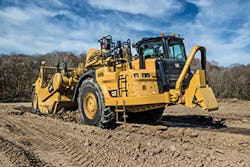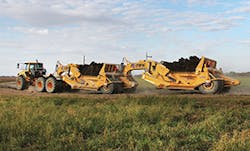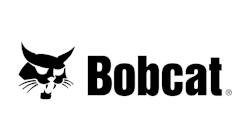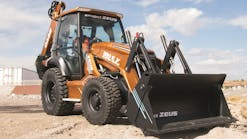When it comes to volumes of dirt moved, the sky is the limit for scrapers, notes Shane Kroeker, vice president of marketing for K-Tec Earthmovers. And, for moving earth on a job site, the scraper serves as a versatile piece of equipment, offering the ability to move a wide range of material and work in a variety of job-site conditions, explains John Gerhold, Caterpillar’s product application specialist.
“They are designed for quick loading, high travel speeds, and the ability to load and dump on the run,” he says of Caterpillar’s wheel tractor-scrapers (WTS), adding that results in yielding fast cycle times help consistently deliver high productivity at the lowest cost per ton. “Other earthmoving systems on the market can become very limited on the material they can handle and/or the job-site conditions they can work in. As a prime earth mover, WTS can work in material that ranges from sand, to rock 24 inches and less in size, and offers the ability to work in high rolling resistance and grade applications.”
Additionally, the Caterpillar WTS is designed to work in “very harsh and challenging applications” and offers the ability for multiple machine rebuilds, says Gerhold.
While pull scrapers are designed to move earth, there are different types of applications for doing so, such as at a landfill, in a mining operation or in road construction, points out Chad Phares, vice president, Humdinger Equipment. “They’re used in different types of applications, but—at the end of the day—their job is to move as much dirt as at least expensively and as fast as possible for the owner of the project,” he says.
Scraper options abound on the marketplace. Caterpillar offers six wheel tractor-scrapers with various capacities and load ratings:
- 621K and 627K: 24 cubic yards, rated load 57,610 pounds
- 623K: 23 cubic yards, rated load 55,000 pounds
- 631K and 631K: 34 cubic yards, rated load 81,600 pounds
- 657G: 44 cubic yards, rated load 104,000 pounds
K-Tec’s 1233ADT Train
In early 2016, Caterpillar announced a new design for its 630K series wheel tractor-scrapers that includes technology for added productivity and operator convenience. The new Cat 630K Series 631K and 637K WTS replace the previous 630G series and feature a complete design update that includes high-pressure steering, engine-over-speed protection, tire spin reduction, differential lock engagement protection, and machine/ground-speed control, plus available systems such as Sequence Assist, Load Assist, Payload Estimator, and Cat Grade Control.
Payload capacity of the open-bowl 631K and open-bowl twin-engine 637K is 34 cubic yards (26 m3), and 50 cubic yards (38 m3) for the coal-bowl 637K. The redesign of 630K Series models also includes features developed for other Caterpillar K Series models. The Advanced Cushion Hitch uses new software to dampen end-of-stoke movement of the load cylinder, designed for a smoother ride. A hydraulic system refinement is designed to simplify the bowl quick-drop function and draft arm overflow guards divert material away from the sides of the bowl.
Other features designed to offer an optimal experience include the new Auto-Stall system to assist in quickly bringing the transmission to operating temperature for faster transitions from torque-convertor drive. New cab interiors feature a redesigned dashboard, visibility, and operator comfort enhancements.
Maintenance improvements include a ground level service filter bank. The Fuel Economy Mode of the 637K adjusts shift points and power distribution for optimum fuel economy. Engine over-speed protection is incorporated to automatically sense engine over-speed conditions based on the rate of acceleration and applies the compression brake or service brakes with no operator input.
Tire Spin Reduction is designed to automatically control the slip of the tractor tires. Differential Lock Engagement Protection is used to prevent the operator from engaging the differential lock when damage could occur.
High Pressure Steering requires significantly less steering effort, resulting in less operator fatigue that helps keep production steady throughout the shift. Machine Speed Limiter is used if site conditions require limiting machine speed for long intervals. The operator can select the top speed through the display or top speed can be set through the Cat Electronic Technician.
The system allows the machine to select the gear that works most efficiently for the engine and transmission load. Ground Speed Control is used when top speed must be limited in short segments of the haul or for intermediate time periods. The operator can set the desired top speed and the machine selects the appropriate gear for conditions.
Sequence Assist uses cylinder-position sensors to automate bowl functions, eliminating up to 14 manual commands in each cycle segment—load, haul, dump, and return—including control of the cushion hitch, transmission-hold feature, and ejector. Sequence Assist allows operators to push the machine longer into the shift and is designed to take the workload off the operators to help with operator fatigue, notes Gerhold.
The optional Load Assist helps less-experienced operators achieve fast, consistent loads. The system automatically adjusts cutting-edge height based on the machine’s speed to manage wheel slip and ensure consistent loading cycles.
Payload Estimator calculates machine payload by measuring bowl lift cylinder pressure at the start of the haul segment. The system is designed to work most effectively when using Sequence Assist to achieve more than 95% accuracy. Payload Estimator is a tool enabling a company’s leadership team to monitor individual machine performance, says Gerhold.
“This feature helps identify if an operator needs help with fleet production while providing a production data base for future estimating,” he says.
Cat Grade Control “intelligently” controls the loading cycle to ensure that the machine does not cut below grade or overfill in the dump area to avoid excess material movement and rework. “This protection allows the prime earth moving system to move and place the correct amount of material, eliminating the rework if targets are missed due to manual operation error,” says Gerhold.
John Deere offers all-in-one systems that feature John Deere-built tractors and scraper pans designed to provide up to 72 cubic yards for one operator running one engine with triple pans behind a tractor, notes Maryanne Graves, John Deere’s product marketing manager.
The systems offer versatility for contractors working in a wide range of conditions: one pan, two pans, triple pans, ejector pans, carry-all pans, two and four tire models of pans, as well as four-wheel drive, and two- and four-track scraper special tractors. The options are designed to offer up to 12% fuel savings and a 17-inch longer wheelbase.
The focus of scraper pan choices is between a four-wheel drive tractor and scraper system, versus the self-propelled scraper, notes Graves. “When you look at the initial investment in a four-wheel drive, it’s about a third of the investment and half of the labor because you only need one operator,” she says, adding the system is designed to provide a savings of 50 cents per cubic yard of material moved.
A carry-all scraper is indicated in situations where a contractor is dealing with material that is light, loose, or sandy, and needs a simple dump action. Ejector scrapers are chosen for material that is heavy, wet, or sticky, and the need for hydraulic cylinders to push the material out.
John Deere’s integrated technology is designed with a touchscreen display, a compression braking system, efficiency manager, and Autoload, providing consistency and productivity pass after pass, notes Graves.
As such, the systems offer versatility in how operators need to use the equipment in response to the various configurations and soil types in which contractors operate, she says. “They can direct load, top load, push load, and auto load,” she says. “There are four wheel drive tractors, two track, and our latest four track tractors, through the introduction of the 9RX series.”
K-Tec’s high-capacity scraper models range from 28- to 63-cubic yard capacity, with the ability to train scrapers in tandem to carry a heaped capacity of 72 cubic yards, says Kroeker.
K-Tec scrapers are versatile in that they can be push-loaded and top-loaded and have excelled in loading topsoil, clay, sand, coal, gravel, or gypsum rock for various job-site materials, says Kroeker.
“For further versatility, K-Tec’s popular bolt-together 1233 model allows for the contractor to easily swap hitch poles so that the scraper may be pulled by either a tractor or an articulated dump truck,” he adds. “This factor maximizes fleet versatility, reduces downtime, and provides for a higher resale value.”
Phares notes that Humdinger Equipment offers various-sized scrapers. One such scraper is the H620 heavy-duty pull scraper, featuring a 20.5 cubic yard rated capacity, 130 inches cut width, 12-inch depth of cut, 143-inch transport width, and 29.5 x 29 standard tires.
It is designed with a tall ejector to prevent carry over, an abrasion-resistant AR steel floor, pushable rear frame and bumper, adjustable reversible cutting edges, and 6- or 8-inch hitch ball designs. Hydraulic lines are designed to be routed for long life. The scraper has plated fasteners, pins, and hydraulic components.
The scraper has a brake option and a depth gauge. The company’s tractor-towed pull scraper has been designed to reduce costs and increase efficiency over a self-propelled scraper or truck and excavator earth-moving equipment system. Given the options on the market, there are a number of factors that go into the process of selecting a scraper.
Gerhold points out there are five questions every contractor should ask when selecting the correct hauling system, machine size, and fleet sizing:
- What type of material will need to be moved?
- What are the climate conditions?
- How much material is required to move?
- What’s the timeframe needed to move the material?
- What’s the haul road profile: distance, rolling resistance, and grade?
“The answers to those questions help determine which wheel tractor-scrapers fit the need for size and productivity,” he says. That may include an open or elevated bowl; a single or twin engine; the WTS machine size; and the choice of self-load, push pull, or push load.
Kroeker cites six factors to consider when determining which earthmoving equipment combination is optimal for a job site—going with an ADT and scraper, or with a tractor or scraper:
- Site condition. A tractor and scraper combination is preferred for soft, spongy soil, while an ADT scraper is indicated for hard, rough soil, and steeper grades.
- Haul length. A tractor and scraper combination is ideal for short haul distances of a half mile and less for cut and fill applications. In longer haul distance beyond one-half mile, an ADT and scraper combination is ideal to achieve the 30 mph and higher transportation speeds to shorten cycle time.
- Material. Topsoil, clay, sand, and gravel may easily be moved with either combination, but shot rock and gypsum are recommended for ADT scraper combinations.
- Volume. ADT and scraper combinations are indicated for earthmoving projects with more than 250,000 cubic yards. Tractors and tandem scrapers are used for large earthmoving projects with a short haul road.
- Longevity. ADT and scraper combinations are ideal for projects with long durations and working hours.
- Cost. Tractor and scraper combinations have a 20 to 30% affordability advantage over ADT and scraper combinations.
“Should a project have millions of yards required to be moved or a requirement to move a mass amount of material in a short timeframe, increasing the scraper fleet size is the solution to meet these goals successfully,” says Kroeker.
There are instances where a contractor will need more than 10 new scrapers immediately onsite as soon as they are awarded a large project, he points out. The company’s website offers a cost analysis calculator tool to help determine how many scrapers are required for a contractor to reach and exceed annual goals of material to be moved.
If a contractor is involved with an earthmoving project and already owns an existing power unit, such as a tractor or articulated dump truck, “the decision to use a pull-pan construction scraper is simple to minimize capital expenditures for the operation,” says Kroeker.
Phares notes a correct analysis of those factors involved in selecting a scraper are critical in calculating job times in order to figure out a project’s overall cost.









